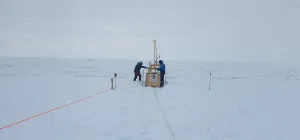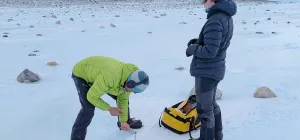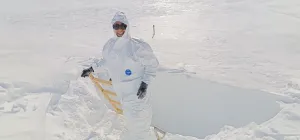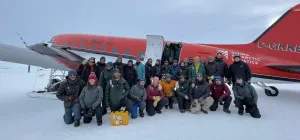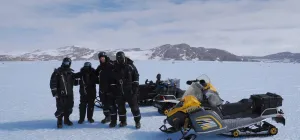New Teams of Scientists Get to Work in Second Half of Season

The scientific teams scheduled to conduct research during the second half of the 2019-2020 season arrived at the Princess Elisabeth Antarctica on January 13th, and were welcomed to a station in full swing. After following the usually necessary first aid and safety training required of all newcomers to the Princess Elisabeth Antarctica, researchers from the BioFe, BELAM, and MICROBIAN projects got to work on their respective research objectives for the season.
BioFe
Dr. Kate Winter from Northumbria University in the UK has returned to Antarctica for the second of two seasons of the BioFe project, which is currently being funded thanks to the generosity of the Baillet Latour Antarctica Fellowship.
Kate is studying how iron-rich nutrients are transported via glacial debris as glaciers flow towards the coasts of Antarctica. Once the glacial debris arrives in the Southern Ocean, the iron in the debris nourishes phytoplankton, tiny organisms alled primary producers that form the base of the ocean food chain. While they grow, these phytoplankton also take in carbon dioxide (CO2) from the atmosphere, and sequester the carbon at the bottom of the ocean when they die and fall to the sea floor.
Last season, with the help of the IPF team, Kate was able to take ice radar images to see the topography of the glacier-bedrock interface along transects of interest in the vicinity of the Princess Elisabeth Antarctica. Knowing the topography of the bedrock can indicate how the debris carrying the iron-rich nutrients flows towards the coast. This season, Kate is taking more ice-radar transects to compliment the ones she’s already taken.
In order to study how debris falls off of rocky outcrops in the vicinity of the Princess Elisabeth Antarctica, last season Kate took aerial drone footage of these rocky outcrops and installed Raspberry Shake seismographs around them to detect when debris falls off and reach the rock-ice interface at the edges of the outcrops. This season, Kate will take new drone footage of the same rocky outcrops to see how much debris they may have lost over the last year. She’ll also collect data from the Raspberry Shake seismographs to see how much seismic activity caused by falling debris was registered over one year.
While Kate was able to bring one of her students to assist her in the field last season, this year, due to students’ unavailability, Kate decided to bring her husband, Ross Winter, to give her a hand. A trip to Antarctica is certainly a once in a lifetime experience for any couple!
BELAM
Speaking of Baillet-Latour Antarctica Fellowship Laureates, one of the Fellowships’ previous laureates from 2010, Steven Goderis from the Vrij Universiteit Brussel (VUB), has returned to Antarctica after many years under the BELAM project to work on a similar project to the one that won him the 2010 Fellowship: hunting for micrometeorites that can give clues to the origins of our Solar System.
As in his previous expeditions to Antarctica, Steven and the BELAM team is spending several weeks out on the Nansen Blue Ice Field on the Antarctic Plateau 120 kilometers from the Princess Elisabeth Antarctica. Accompanying Steven are Naoki Shirai, a colleague from Tokyo Metropolitan University in Japan, as well as Hamed Pourkhorsandi an Iranian post-doctoral researcher at the Université Libre de Bruxelles (ULB) and Mehmet Yesiltas from Kirkareli University in Turkey.
Meteorites - which are defined as extraterrestrial bodies that fall through the Earth’s atmosphere (as meteors) and make it to the ground - fall all over the surface of the planet. Smaller meteorites, called micrometeorites, are rather common. However, due to their dark colour, micrometeorites can be difficult to distinguish from normal rocks or soil in most parts of the world.
However, in Antarctica, micrometeorites are much easier to find. Areas where blue ice is abundant, such as the Nansen Blue Ice Field where the BELAM team is collecting meteorite samples, are particularly good places to find them, as they stand out against the clear, blueish-tinged ice around them. Becoming trapped in the blue ice also preserves the micrometeorites against erosion.
The micrometeorites can have multiple origins. Some can even come from the same rocks that eventually formed the Moon or Mars.
This season, the group of scientists will stay in the Nansen Ice Field for three weeks before returning to the station, after which they will all fly home with the meteorites they collect. The meteorites will be shared between the research institutions. In Belgium, the micrometeorites will be added to the existing collection at the Royal Belgian Institute of Natural Sciences.
Financing for BELAM is made possible by the Belgian Federal Science Policy Office (BELSPO).
MICROBIAN
The MICROBIAN project is returning to Antarctica for its third consecutive season to continue analyzing the microbiological communities living at and around the Princess Elisabeth Antarctica. While there are a great number of microbiological sampling activities taking place all along the coasts of Antarctica, there aren’t so many being done in the interior of the continent.
This unique environment at the station - which, being 200 km inland from the coast, tends to have a much harsher climate than the coastal regions - is why the Princess Elisabeth and its vicinity is an ideal place for the MICROBIAN project to spend a few seasons taking samples of microbial life. It will be interesting to see if there are any significant differences between microbial life at a small scale on different nunataks near the station, or compared to the coastal regions of Antarctica.
The project is a collaboration between Ghent University and the University of Liège, two universities in Belgium specialised in microbiological research. This season, Valentina Savaglia, Quinten Vanhellemont, Beatrice Ronsero, and Juri Kusak are spending four weeks around the station taking samples, which will be brought back to Belgium at the end of the season.
MICROBIAN is also a research project financed by the Belgian Federal Science Policy (BELSPO).
Japanese research projects
A few days after the arrival of the first teams doing work at the station during the second half of the 2019-2020 season, a group of Japanese researchers from the Japanese National Institute of Polar Research (NIPR) arrived to use the Princess Elisabeth as a base from which to conduct their research expeditions in the area.
Auroral Observations
The first project the Japanese team of researchers are working on is building an aurora observation network along the coast of the Dronning Maud Land in East Antarctica. Two scientists, Akira Kadokura and Yoshimasa Tanaka, are installing at and around the Princess Elisabeth Antarctica an unmanned Auroral Observation system (UAO-2), which is composed of a Fluxgate Magnetometer, an aurora camera and a Global Navigation Satellite System (GNSS) antenna. The magnetometer is being installed on Utsteinen Ridge, while the camera and GNSS antenna are installed on the roof of the station.
The goal of their research is to study on the onset mechanisms of auroral substorms (which produce mild aurora), the temporal and spatial variation of the auroral phenomena, but also the wave-particle interaction process during an auroral substorm and a full on auroral storm (which produce vivid auroras).
Biological research
A second team of NIPR researchers, Kensuke Tadome and Shohei Hayashi, will study the origin and transition between different biological ecosystems in Antarctica. The team will not only look at current ecosystems, but also try to reconstruct ecosystems from the regions recent past to see if there have been any significant changes in ecosystem boundaries.
The team of researchers plans to compare the biodiversity of the Enderby Land near the coast of the Dronning Maud Land and the Sør Rondane Mountains. They plan to sample two kinds of life in ice-free areas in these two locations during their research expedition:
Actinomyces: These are a particular kind of bacteria that exist in soils, and can be useful for developing new drugs. The team plans to see which groups of bacteria are present, and what specific characteristics they may have.
Lichens: The team plans to investigate how many species of lichens existing the project study areas, in particular if there are any differences depending on varying geological and geographical conditions. They also hope to gain insight into the origins of the different lichens, as there is a very high diversity in varieties of lichens in Antarctica.
Expert Field Support
As always, the team at the Princess Elisabeth Antarctica will be providing field guides to ensure the safety of field expeditions and assist researchers with their fieldwork. The station’s cook prepares readymade meals that can be heated up and eaten whenever needed, and are packed to stay fresh even during weeks-long research expeditions in the field.
Science in Antarctica is a great adventure!
Download











